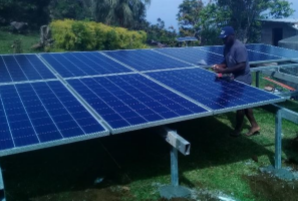
Burning of fossil fuels and petroleum to produce energy for electricity releases greenhouse gas emissions into the atmosphere causing climate change.
The Government of Vanuatu through the Ministry of Climate Change are taking concrete actions to mitigate climate change by promoting the use of Renewable Energy (RE) and Energy Efficiency (EE) technologies. These will help contribute to achieving sustainable energy, energy access, energy savings and greenhouse gas reduction.
With funding from the Global Environment Facility (GEF) and implemented through the United Nations Development Programme (UNDP), the Department of Energy is implementing an energy project called ‘Barrier Removal to Achieve National Energy Road Map Targets for Vanuatu (BRANTV)’. BRANTV is initially supporting 40 communities with solar Photovoltaic (PV) and pico hydropower systems.
Since November 2019, BRANTV has installed community-scale solar PV systems with capacities ranges between 1100 W to 3300 W in five communities. The communities have a total population of 845 of which 47% are women. With co-financing from Government, the BRANTV project is providing incremental costs so that the baseline activities achieve their greenhouse gas emission reduction targets. As such, green electricity is made readily available for productive uses in the community. The communities use deep freezers, copra and kava processing machines, sewing machines, computers, printers, etc for subsistence and commercial purposes. Additional income earned from productive uses are set aside to cater for operational and maintenance costs.
The BRANTV project is expected to significantly impact on the socio-economic development of these communities given the fact that electricity is an essential service for improving livelihoods in Vanuatu. Having access to reliable and green electricity in homes will improve the capabilities of children’s learning as they will have better lighting to study under and charging of mobile phones will improve communication with families and friends and help them keep in constant contact. Communities can now store their food for later use or for sale. A reliable source of electricity will also be available for workshop repairs, storage of vaccine in health centers, and good lighting for maternal care.
In Utanlangi community, feedback on the recently-installed community-scale solar PV system is quite remarkable. With enough power provided to the community centre, community activities and participation in community work is strengthened - the community center was cleaned, a notice board was set-up and a proper traditional ‘tamtam’ (stage) was set-up for making community announcements. Capacity for storing fish for subsistence use and commercial purposes is improved, and income generated from fees levied on cold storage of fish, water and frozen food is increased. According to Annie Willy, the Secretary to the village council and responsible for fishing project, “the overall income collected from fishing activities alone in 2019 was more than VT100,000 and money collected from community activities was more than VT 300,000”. The manager for the Information, Communication and Technology (ICT) room, Mr. Willy Fred reported an increase in demand for printing of education materials and other community events and therefore increasing the income on levies collected for printing costs. The youth are now organizing activities in the community hall which has become a common meeting place for socializing. Community events and celebrations are also happening in the well-lit community hall - such as Independence Day celebrations, weddings, and Christmas and New Year celebrations.
The BRANTV project is currently designing a pico-hydro PV solar hybrid demonstration activity for Loltong in collaboration with the Utility Regulatory Authority (URA). The BRANTV project is also conducting site inspections to demonstrate community-scale PV solar systems of the following sites: (i) Nerenigman on Mota Lava; (ii) Sara on Epi and (iii) Nofo on Emae island; and demonstrate family-compound PV nano-grid site at Loh Island.